M/S
Seaven Seas, built to become the USS Long Island (1941), Sold in
1941 & renamed M/S Nelly, In 1953 rebuilt and renamed M/S
Seven Seas sold in 1966

Click the logo above to reach the
ssMaritime FrontPage for News Updates
With
Reuben Goossens
Maritime Historian, Cruise‘n’Ship
Reviewer, Author & Lecturer
Please Note: All ssmaritime and my other
related ssmaritime sites are 100% non-commercial and privately
owned sites. Be assured that I am NOT associated with any cruise
or shipping companies or travel/cruise agencies or any other
organisations! The author has been in the passenger shipping
industry since May 1960 and is now semi-retired, but continues to
write article on classic liners and cruise ships in order to
better to inform cruise and ship enthusiasts for their pleasure!

Image
from the author’s collection
On ssMaritime.com, we pride ourselves in
diversity, for we do not just cover the great Liners, but also
ships that are more modest and less known. The ms Seven Seas
fall’s into the latter category. Does this mean she is of
lesser importance in relation to maritime history? No certainly
not, for during her thirty-seven years, she had an eventful and a
most interesting career, be it at war or as a migrant ship, a
university at sea, a liner and a cruise ship and finally a
workers hostel.
The Seven Seas certainly has a story to tell,
and I trust it will bring back many memories to those who sailed
and lived on her.
The Seven Seas was originally laid down as a
standard C3 class cargo ship at the Sun Shipbuilding & Drydock
Company, in Chester, PA, USA – Yard 184, for the
Moore-McCormack Line as the MS Mormacmail and she was launched on
January 11, 1940. However with the war coming on she never sailed
under that name. It was prior to her completion that she was
transferred to the US Navy and she was totally transformed to
become an auxiliary aircraft carrier at the famed Newport News
shipyard.
USS
Long Island:
On June 2, 1941 the US Navy officially
commissioned and renamed the ship as the USS Long Island. A ship
of war with long flight deck topside that extended from her stern
to above and forward of her bridge, and she had the capacity to
accommodate from 16 to 21 aircraft in her main hanger located
below deck.
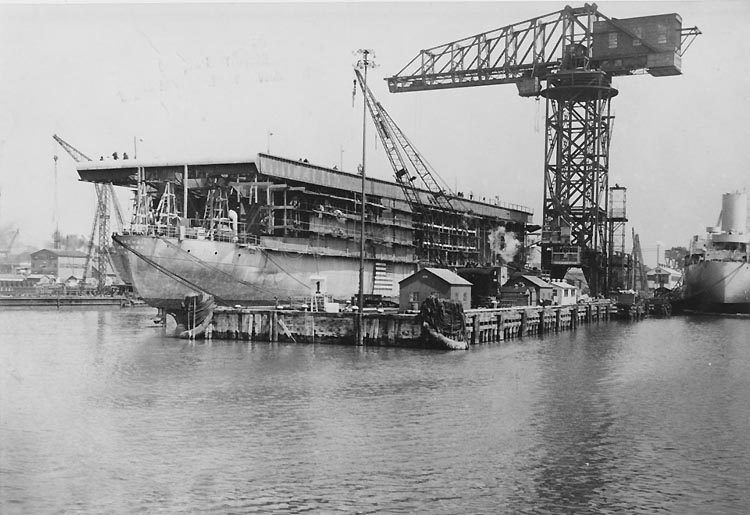
The AVG-1
Long Island in construction
She was armed with one 5-inch gun and two
3-inch guns as well as other guns. It is important to note that
the USS Long Island was the very first escort aircraft carrier of
the United States Navy to be employed in the war! Her official
signal code’s was at first “AVG-1”, then
“ACV-1” and finally “CVE-1.”
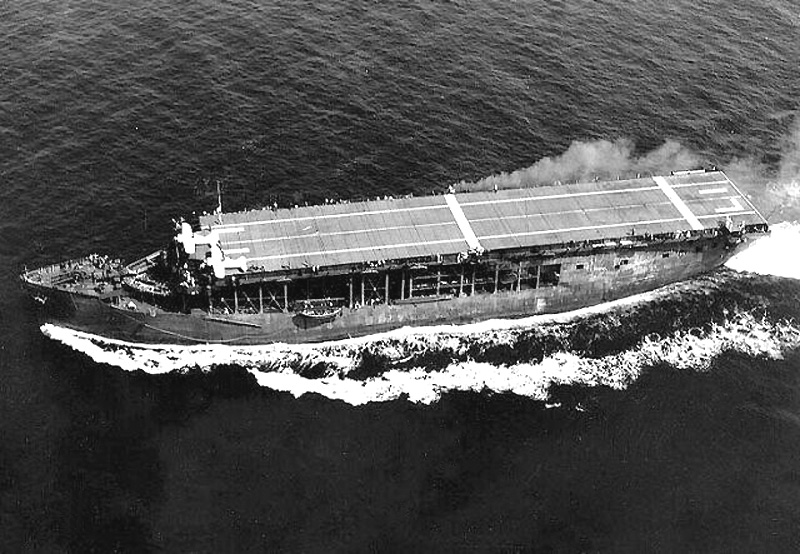
A fine
photo taken from the air showing her flight deck and her early
plain grey paintwork
Note her
smoke stack on the starboard side and the two aircraft forward on
the flight deck
Photograph
from the author’s private collection
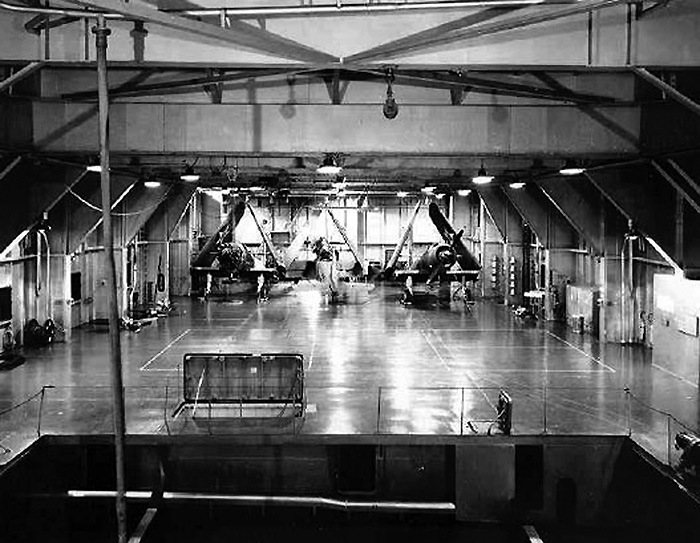
Here we see
USS Long Island’s hanger deck
Photograph
from the author’s private collection
She operated first in the Atlantic region for a
short time, but she soon was transferred to the Pacific where she
spent the remainder of the war years being involved in the famed
“Naval Battle of Guadalcanal.” The USS Long Island had
a proud record and was involved in many battles during her time
in the Pacific and she did her name and her country proud!
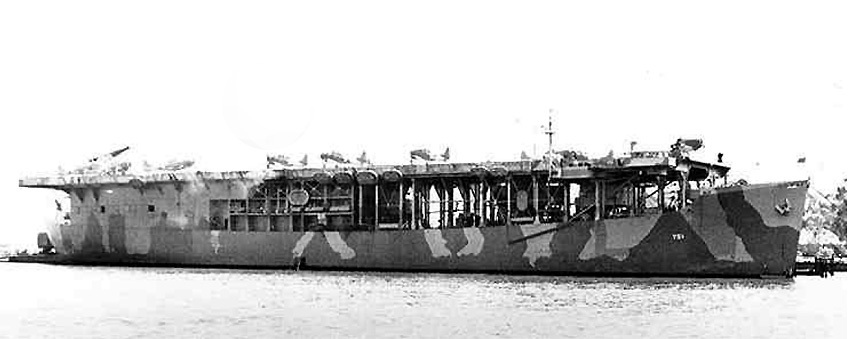
Here we see
some a good number of aircraft on the flight deck and featuring a
camouflage livery
Photograph
from the author’s private collection
Thankfully, unlike so many other ships of her
kind, she served her wartime duties and returned to the United
States unscathed, where so many ships had been destroyed and
sunk. With the USS Long Island having been the first of her class
to enter the conflict and a ship that had fought so bravely
having been in the centre of so many conflicts, especially in the
Pacific she was honoured with not only a “Battle Star”
but also a special “Plaque” by the Unites States
Government to honour her proud service! This Plaque remained on
the ship to her closing days. She was decommissioned on March 26,
1946 and the MS Long Island was released from service and laid up
with the many other C class ships, which were now all redundant
and idle.
MS Nelly:
Having been laid up since March, 1946, the MS
Long Island remained laid up with the countless other C-3 class
ships, but it was two years later, on March 12, 1948 that she was
purchased at an auction by Caribbean Land & Shipping Co,
being a Swiss based company who obtained her as a freighter. It
was not until February 1949 she was renamed MS Nelly being
reregistered in panama, she made an Atlantic crossing from the United
States to La Spezia, Italy where she was extensively rebuilt into
a rather basic migrant ship to operate services to Australia.
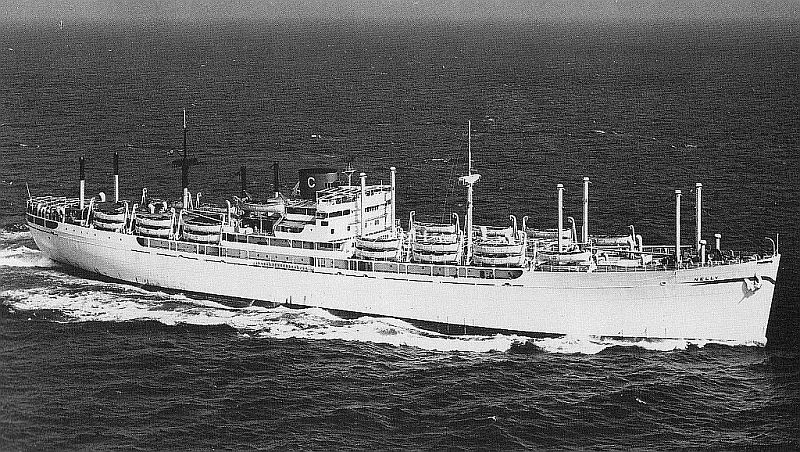
The humble
MS Nelly is seen at sea
Image
from the author’s collection
When completed she was now able to accommodate
up to 1,300 in the most basic of accommodations, being mostly
dormitories with only a few two bedded cabins that could be also
be sold as three or four berth cabins. There were two dinning
rooms with long tables with multiple sitting, and several
lounges, a main lounge, the bar and several other public venues.
There was ample deck space for daytime activities.
The Nelly was placed on the migrant trade to Australia
and her first voyage departed Naples for Australia in June 1949,
sailing via the Suez and Fremantle, but she completed her voyage
in Melbourne on July 17. It would not be until her third voyage
to Australia that she made her first call to Sydney, arriving
there on January 15, 1950.
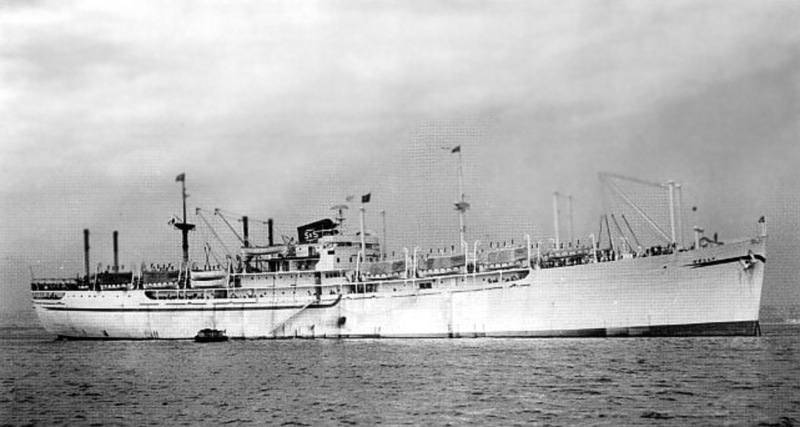
MS Nelly
seen arriving in Sydney in January 1950
Image
from the author’s collection
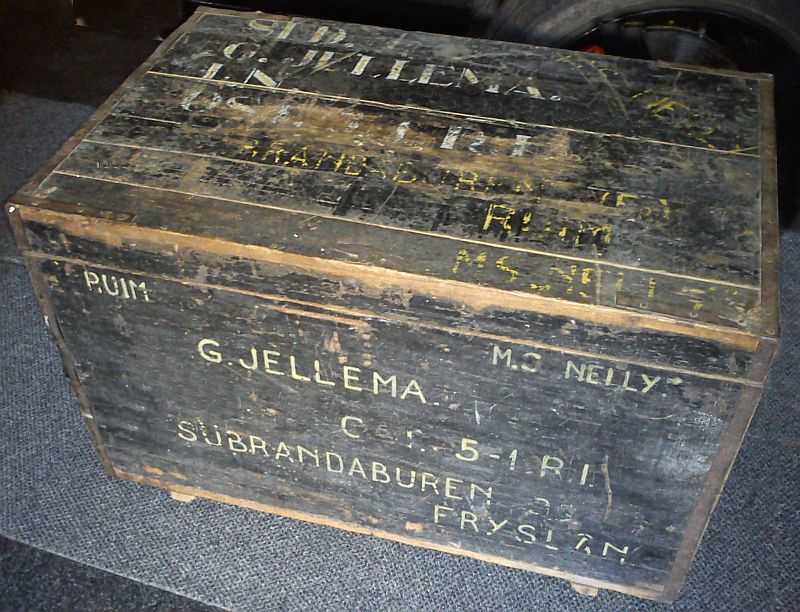
Dutch
soldier G Jellema sailed back to Rotterdam from Indonesia on the
MS Nelly
His son
kindly sent me the photograph of his dear late Father’s
trunk that was kept in the ships hold
Photograph
by and © Sjoerd Jellema
She continued on the Australian run, including
a special voyage to Jakarta to bring Dutch nationals back to the Netherlands.
In addition to her Australian operations, she also operated a
number of Trans-Atlantic crossings to Canada.
MS Nelly’s
Migrant services from Bremen to Melbourne:
It is interesting to note that the MS Nelly was
the very first ship that carried the first German migrants under
the bilateral scheme to Australia, which was signed on August 29,
1952. She departed Bremen under the command of Captain Tallak Nilsen
late in October 1952, and she sailed via Dover (England), Santa
Cruz (Tenerife), Las Palmas (Canary Islands), Cape Town (South
Africa), Fremantle (port of Perth - Western Australia), and she
arrived in Melbourne (Victoria) on December 5. She continued her
services from Bremen to Australia. On various occasions she would
also operate special displaced persons and migrant voyages from Bremen
to Quebec, one arrival on Canada that is recorded was on October
30, 1951, but not many other can be found.
However, on January 1953 the MS Nelly departed Bremen
and Southampton for Melbourne Australia for the last time under
that name. She arrived in Melbourne on February 24, and remained
there for three full days before returning to Bremen. Upon having
returned she was withdrawn from service as she was to be
comprehensively rebuilt and upgraded into a two-class liner.
MS Seven Seas:
Her new role was for her to operate both
migrant as well as regular passenger services, thus she had to
become quite a stylish looking liner with beautifully decorated
public rooms and a superb “Pent House” style First
Class section!
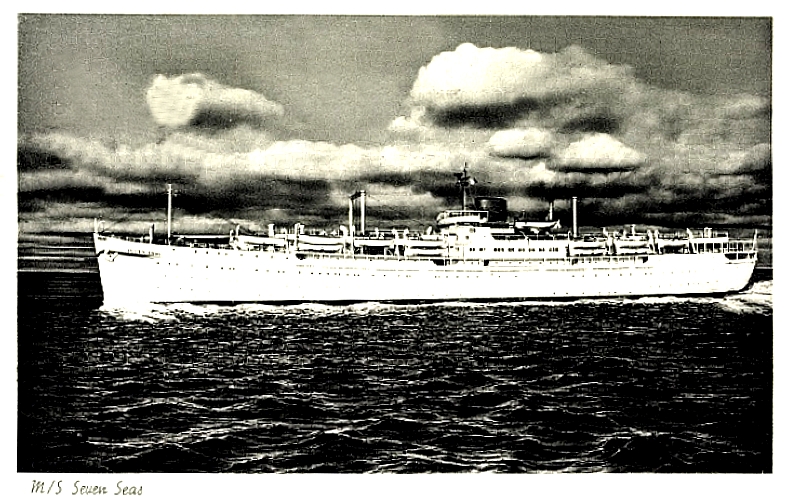
This is a
very early black and white postcard of the MS Seven Seas
Image
from the author’s collection
Upon completion she had been renamed MS Seven
Seas and the all-new looking ship had her superstructure greatly
enlarged, as her decks were extended forward and aft as well as
her bridge house being enlarged. The additional space allowed
more public rooms as well as new accommodations. In addition she
was now being a two-class liner, having accommodations for just
20-First Class passengers who travelled in comfort and in style,
and 987 Tourist Class passengers whose accommodations and public
facilities were of an excellent standard for the times! In fact
her accommodations and lounges were very modern and attractive to
say the least.
The all-new MS Seven seas departed Bremerhaven
for her very first voyage on May 9, 1953 as she headed for Australia
sailing via the Suez Canal and Fremantle, arriving in Melbourne
on June 12. Upon return to Germany she was chartered to the
Europe-Canada Line, which was jointly owned by Holland America
Line and Royal Rotterdam Lloyd, although the Europe-Canada Line
was established especially to provide inexpensive student/migrant
travel to Canada, thus during her career she frequently operated
student voyages to North America, etc, and the Seven Seas
commenced operating frequent Trans-Atlantic voyages.
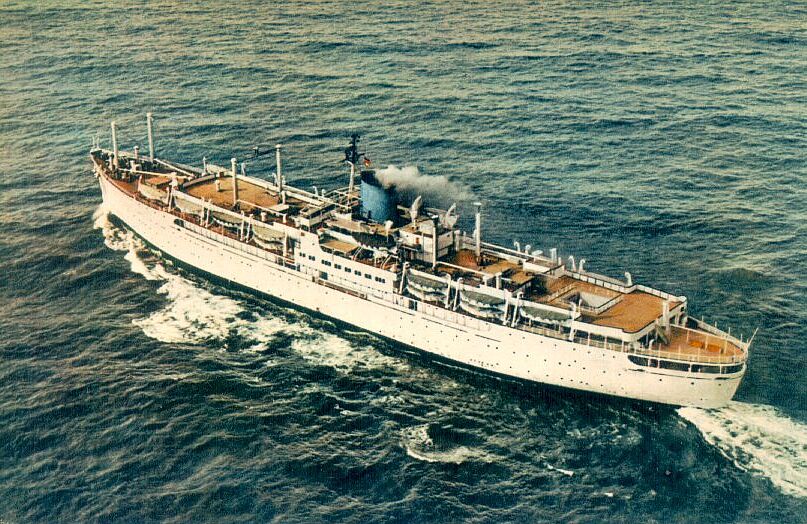
A postcard
of the Seven Seas issued by Europe-Canada Line
Image
from the author’s collection
Her new service departed Bremen sailing via Le
Havre, Southampton to Quebec and Montreal also making occasional
calls to New York. However, whilst she was now seasonally
employed on the Atlantic service, she still operated her Australia
services and as past passenger reminded me who departed Bremerhaven
on October 24, and arrived in Melbourne on November 26 in 1954.
Towards the end of 1955, she was obtained
outright by the Europe-Canada Line and having been registered in Panama
since 1949, she was now reregistered in West Germany. She was now
mostly used on the Trans Atlantic service until 1960, for either
regular passenger services or student voyages,
However, whilst under charter to Royal Rotterdam
Lloyd, she departed Southampton on October 30, 1960 for a special
voyage to Australia and New Zealand and then upon her return to
Europe, she recommenced her regular service from Bremerhaven to New
York.
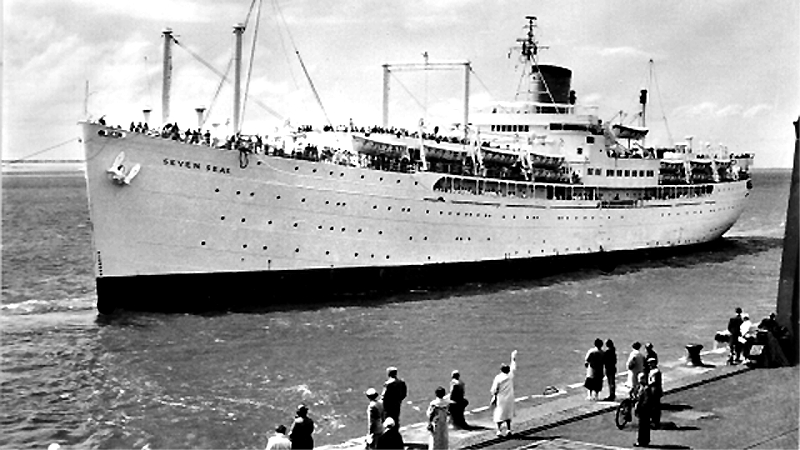
The MS
Seven Seas departs for another long student voyage
Image
from the author’s collection
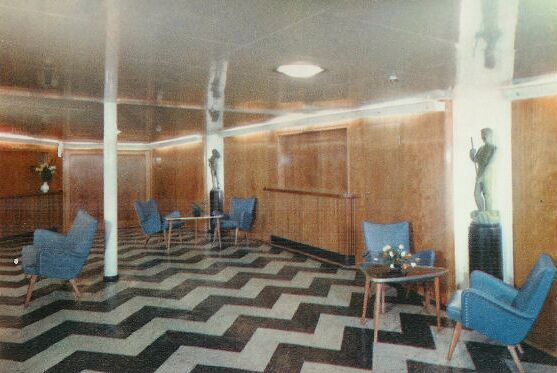
The
Lobby and purser’s Office
A
postcard from the author’s collection
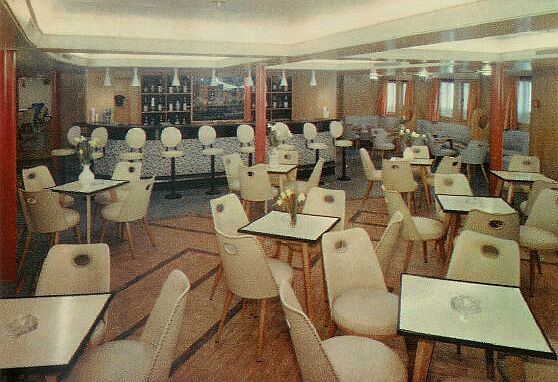
One of the
Bars aboard the Seven Seas
A
postcard from the author’s collection
The
following three images were sent in by Ingo Mosemann of Germany
who served on MS Seven Seas
as a
steward for four years during the early 60’s. I am most
grateful to him.
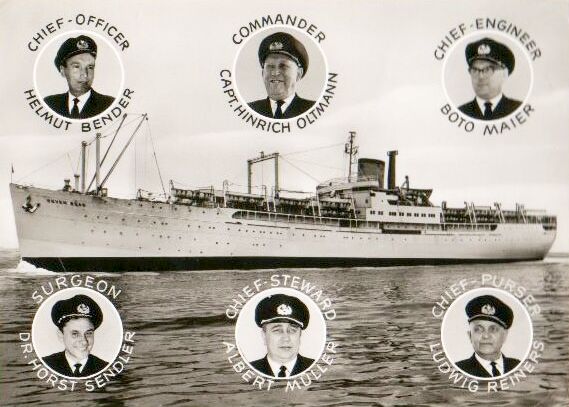
1961
postcard of the MS Seven Seas showing the Captain and senior Crew
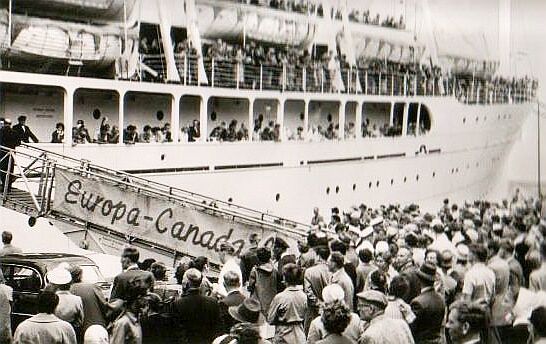
Seven Seas
ready to set sail again!
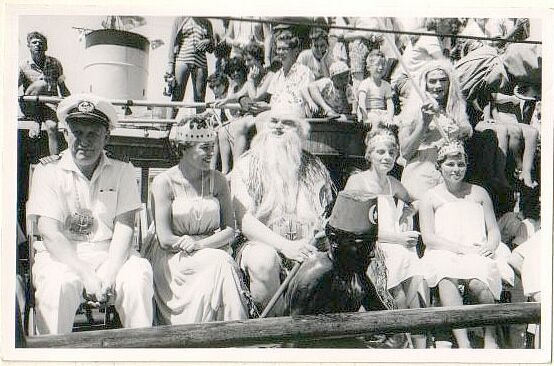
Captain Hinrich
Oltmann, King Neptune and some attractive lady passengers at the
Crossing of the Equator
celebration
during a voyage to New Zealand – This photo was dated 16
November 1961
Photograph
from the Ingo Mosemann collection
The Mark Cameron
story of his voyage to New Zealand:
As my Father was a helicopter pilot and early
in 1961 he found work in New Zealand, but they needed his
presence at short notice, therefore he had to fly to New Zealand
meaning that my Mother, Anne Francis Cameron, nee Parkes aged 21
at the time, had to arrange our voyage, pack up house and home
get ready and eventually we sailed on the MS Seven Seas in the
autumn of 1961 to New Zealand and we joined my Father there. We
sailed from the UK via the Panama Canal and like so many others
we were emigrating from UK on what I believe are called in the
‘Ten Pound Special.’
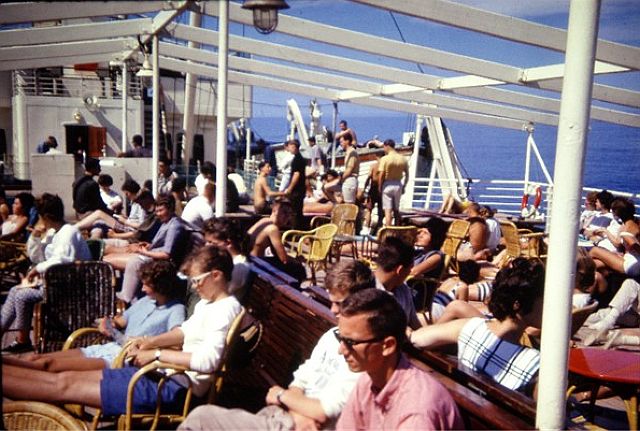
Passengers
enjoying the sun out on the aft deck
We settled down and spent years in Huntley New
Zealand, that is, until my Father was moved on to Africa, for in
those days a helicopter pilot’s job was particularly itinerant
and I can say that it still is. Later I became a pilot myself and
now I fly for Emirates.
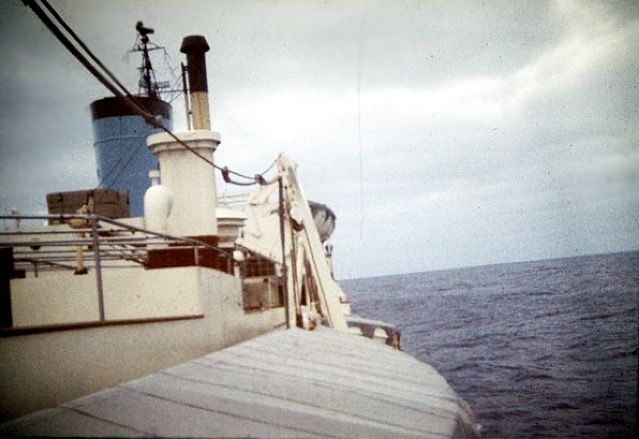
Overlooking
the ocean from atop the ship far aft
The photograph below is of me playing out on
deck and obviously I had a great time aboard. The original is a
slide that has been scanned, repaired and colour balanced. At the
time of sailing my Mother was pregnant with my brother who was
born in 1962, on March 1.
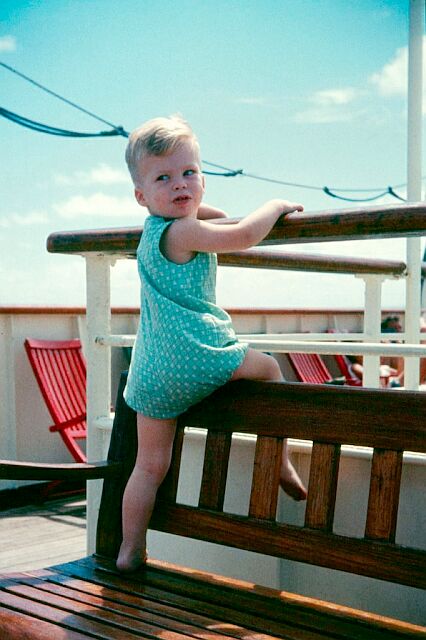
A young Mark
Cameron seen aboard the MS Seven Seas
Photograph
taken by his mother Anne Francis Cameron
Mark Cameron.
***********************************
The Seven Seas made another voyage to New
Zealand, as we have read in Mark Cameron’s story late in
1961/62, as I recall my time on board on that occasion in
Wellington and she was a delight to behold, for all her lounges
were a simple delight and the ship had that something special
about her, it was a feel of comfort, but more-so one of
happiness! The passengers I spoke with were all extremely happy
with the ship especially her crew and not a single complaint was
to be found! Upon her return to Europe early 1962, she returned
once again to her original Canadian duties until April 1963 when
she returned to the New York service.
Having arrived in New York she had been
chartered by the Chapman College to undertake a series of study
cruises for their University of the “Seven Seas”,
visiting various countries! When the charter contract had
completed, the ship proceeded to Amsterdam where she was taken
over by Holland America Line once again for a voyage to Australia
departing Amsterdam in March 1964 sailing via Fremantle on April
28, then to Melbourne and Sydney. She departed Sydney on May 6
and sailed via New Zealand, the Pacific, Panama Canal bound for New
York. From New York she recommenced on another season operating
as a floating university.
Engine Room
Fire at Sea:
However, tragedy struck the ship when late on
Saturday July 17, 1965 the engine room was disabled by fire,
whilst she was located around 500 miles from St. John’s Newfoundland’s,
Canada. The ship drifted hopelessly at sea having no power, and
the captain quickly issued a letter to all passengers to assure
them that help was at hand, for a call had gone out and the Dutch
Ocean Going tug “Ierse Zee” as well US Coast Guard
vessel “Absecon” soon came to the rescue. The tug being
already at sea and close by reached the stricken liner on Monday
July 19, and commenced a slow tow, thereafter the Coast Guard
vessel arrived, which improved the towing speed arriving at St.
John’s on Friday July, 23. Upon arrival her passengers
disembarked and were transferred to their destination, New York
City!
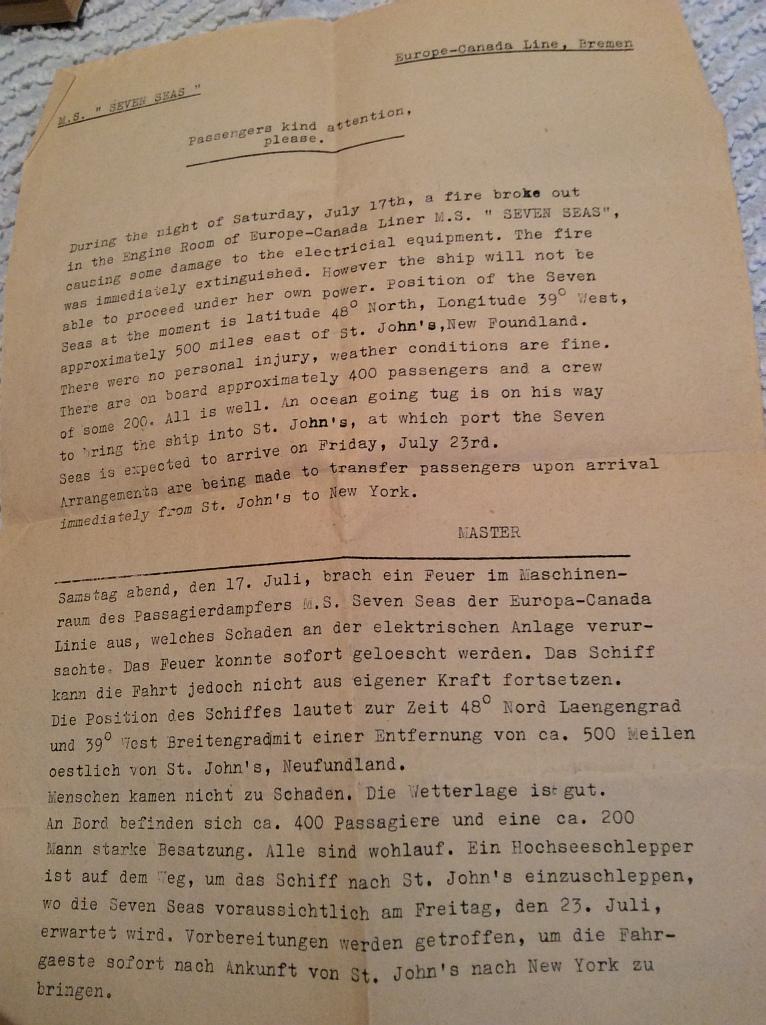
An official
notice to passengers in English & German informing them of
the fire situation and what was going to happen
This
notice was provided by Stephane whose Mother sailed on this
voyage
She was taken to a shipyard where the ship
would undergo considerable repairs. These repairs kept her out of
service for a considerable time, for she would not resume
services again until early 1966.
She was chartered to operate as an American
floating university, thus the Seven Seas departed Los Angeles on
Thursday February 10, 1966 and sadly this would also be her very
last voyage to Australia. Sailing via the Pacific Islands and New
Zealand, she arrived in Sydney on Tuesday March 8, where she
remained for two nights and departed on March 9; she then headed
south and west for Fremantle and sailed via India to the Middle
East to some European ports and then the Seven Seas returned to New
York.
Having returned to New York from her floating
university world voyage, the wonderful MS Seven Seas commenced
her final summer season of Trans-Atlantic services, however she
was finally taken out of service in September 1966, having
operated as a successful and a popular passenger liner for
seventeen years, although the ship was in fact twenty five years
old and had sailed around the globe so many times, as well as
countless Trans-Atlantic voyages! As a maritime historian, I
receive emails from past passengers regarding many ships, but the
Seven Seas is always one ship that comes up more and more, for
she was and seems to remain a greatly loved ship, for “her
crew were amazing” her “lounges were a delight”
and “she had that special atmosphere that made us and all on
the ship always feel so happy.” Externally she never looked
much, but internally she was a delight, as I know well, on Pages
Two & Five you will discover her interiors - See the INDEX at
the bottom of the page.
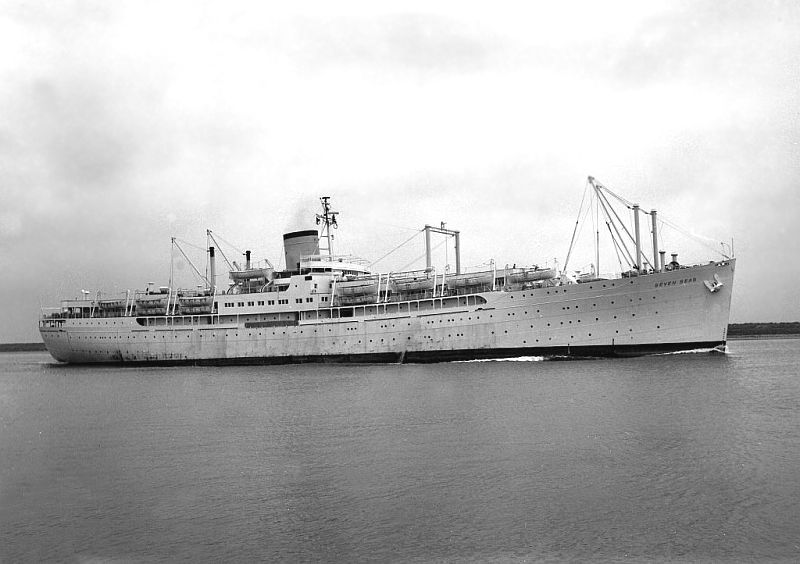
The MS
Seven Seas is seen her towards the latter days of her career!
Sent in
by a supporter, but photographer unknown *See photo notes at
bottom of page please!
Her Final Days:
With the Seven Seas having been withdrawn from
active duties in September 1966 she was rapidly sold to a Dutch
company the “Student Lodging Company” and she was
relocated to the great harbour city of Rotterdam in the
Netherlands and she was and berthed along the Parklaan at “Parkhaven”
close to the famous “Euromast.” During this time she
was used as a student accommodation ship as well as a campus for
medical students for the nearby famed Medical Faculty Rotterdam,
the “Erasmus University.” It is said that she hosted at
least 2,000 students up to January 1971.
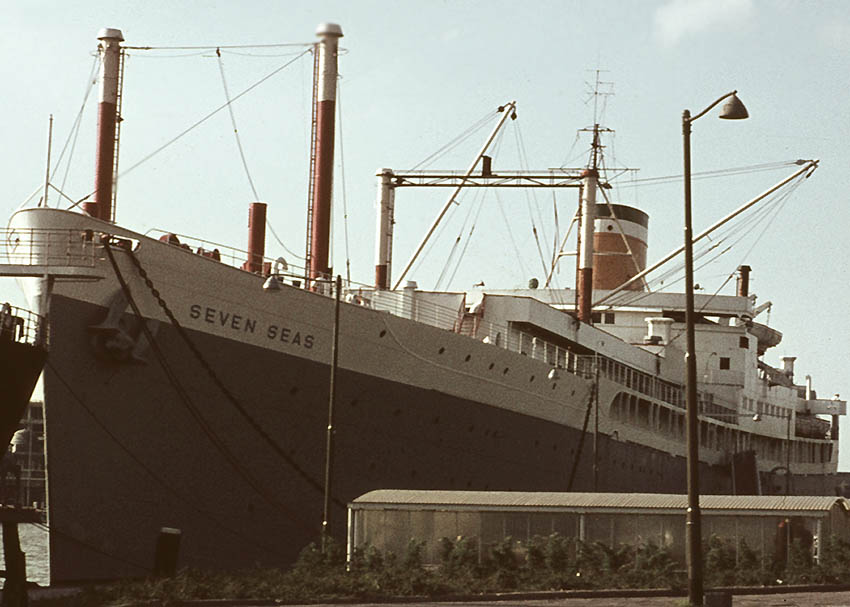
The Seven
Seas seen in Rotterdam as a student accommodation ship as seen in
September 1968
Photograph
taken by & © Ray Little (UK)
Dr. Jack Angenent MD, who was kind enough to
write to me in regard his time spent on board the Seven Seas, for
he, both lived and studied aboard her until her final days as a
student/university ship, from September 1968 to January 1971. I
hereby wish to thank Dr. Jack Angenent MD for the following
photographs of the ship seen berthed alongside at the Parklaan as
well as one on board.
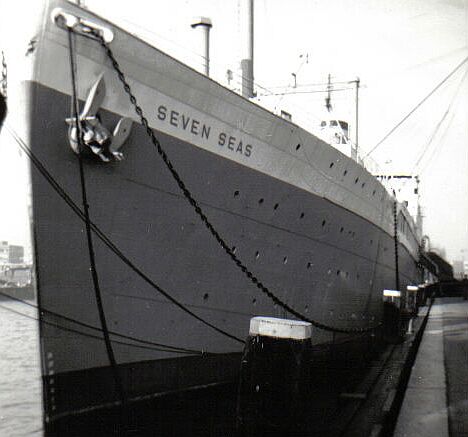
Seven Seas
is seen berthed at Parkhaven, Rotterdam from 1968 to 71
The
three Photographs below are by & Copyright © Jack
Angenent
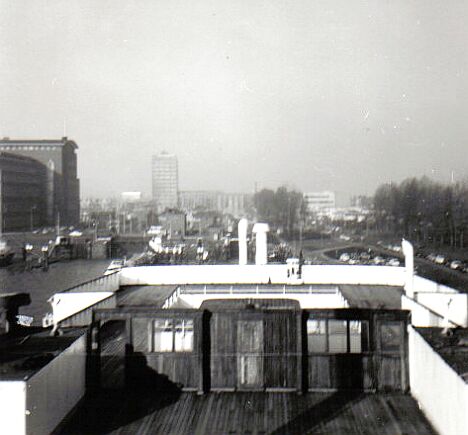
Sports Deck
and swimming pool
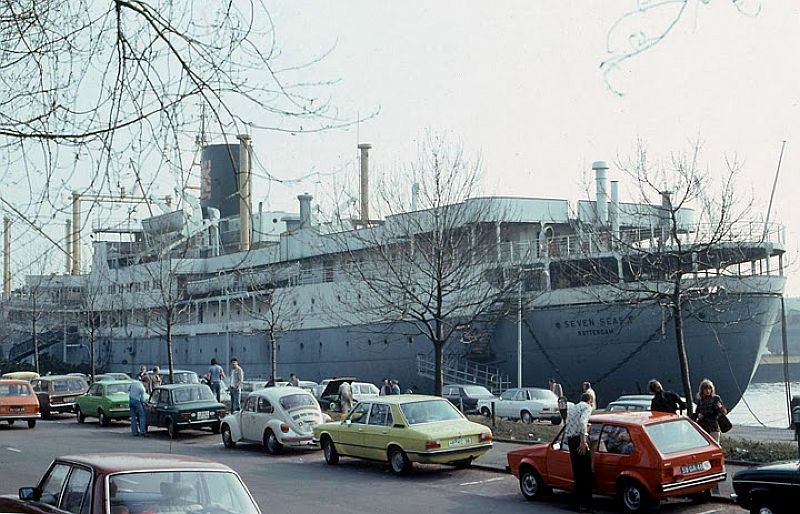
She had her
funnel painted with new colours in 1971 having been sold
However, in February 1971 the Dutch company
“Verolme” purchased the Seven Seas from the
“Student Lodging Company” and she was relocated to
another berth in Rotterdam where she was used this time as a
floating hostel for overseas (mostly Eastern European and Middle
Eastern) workers in Rotterdam. She operated as a workers hostel
for six years, but she was finally sold to be broken up in April
1977. On May 4, she departed Rotterdam under tow arriving the
next day at the “van Heyghen Freres” breakers yard at Ghent,
Belgium.
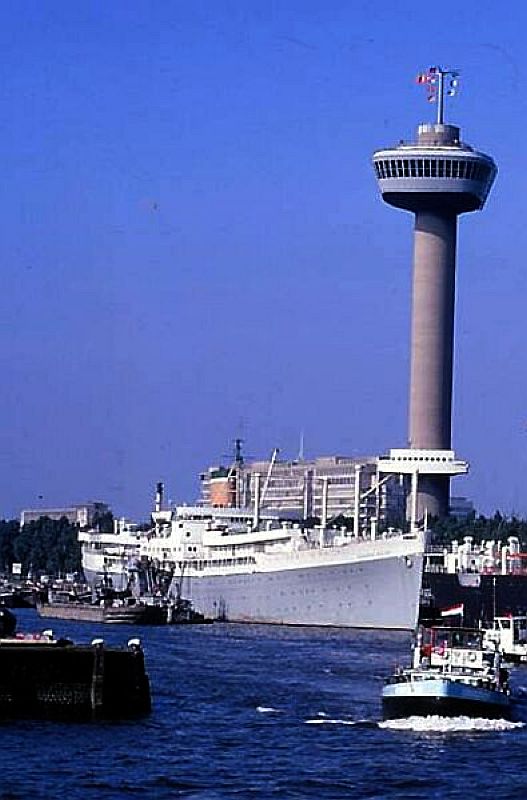
She is seen
here in Rotterdam with the “Euromast” behind her. The
mast has since been greatly heightened.
The Bridge
on the mast is a replica of the Holland America Lines SS
Rotterdam Bridge, built in 1958
Image
from the author’s collection
MS
Seven Seas - Specifications:
Built:
Sun Shipbuilding & Dry Dock Company, Chester, PA
- USA.
Yard:
184.
Tonnage:
13,523 GRT.
Length:
150.0m / 492ft.
Beam:
21.2m / 69.6ft.
Draught:
8.68m / 28.5ft.
Engines:
Busch-Sulzer geared diesels.
Screws:
One - 9,000 BHP, 16.5.
Speed:
17 knots.
Air-conditioning:
Partial.
Passengers:
First Class, 20.
Tourist Class, 987.
Crew:
192.
Seven
Seas Index:
Page
One - Ships History Page.
Page
Two - Photo Album.
Page
Three - The Maat Families Atlantic crossing.
Page Four
- Frans Mast sails in 1957 to New York.
Page
Five - Arthur Lukach & friends
sails to and from France in 1954.
“Blue Water Liners sailing to the
distant shores.
I watched them come, I watched them go and I watched them
die.”
********************************
Use the Back
button on your browser or Close the Page to return to the
previous page
or go to our INDEX
ssMaritime.com
& ssMaritime.net
Where you will discover over 1,250 Classic Liners
& the 1914 built MV Doulos Feature
Photographs on ssmaritime.com, & .net and
associate sites are by: 1. By the author. 2. From the
author’s private collection. 3. Or as provided by Shipping
Companies and their Publicity Companies as well as by private
photographers or collectors. Credit is given to all contributors.
However, there are some photographs provided without details
regarding the photographer concerned., therefore I hereby invite
if owners of those images to be so kind and make them-selves
known to me per email at rg@ssmaritime.com
in order that due credit may be given
ssMaritime
is owned and © Copyright - Reuben Goossens - All Rights Reserved

























